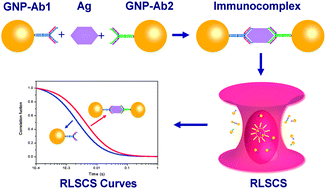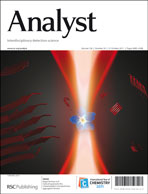In this paper, we reported a single particle technique for the one-step homogeneous immunoassay of a cancer marker by resonance light scattering correlation spectroscopy (RLSCS). The setup of RLSCS was similar to fluorescence correlation spectroscopy (FCS), and its principle was based on measuring the resonance light scattering fluctuations in a small volumes (less than 1 fL) due to Brownian motion of single particles. In homogeneous immunoassay, we used a sandwich strategy and conjugated two different antibodies (Ab) with gold nanoparticles (GNPs) respectively. When two different GNPs labeled with antibodies are mixed in a sample containing antigen (Ag) targets, the binding of targets will cause GNPs to form dimers (or oligomers), which leads to the significant increase in the characteristic diffusion time of GNPs in the detection volume. The RLSCS method can sensitively detect the change in the characteristic diffusion time of GNPs before and after immune reactions. We used this technology in homogeneous immunoassays for the liver cancer biomarker alpha-fetoprotein (AFP). The conditions of the immune reaction were investigated systematically. In the optimal conditions, the linear range of this assay is from 1 pM to 1 nM and the detection limit is 1 pM for AFP. This new method was successfully applied for the direct determination of AFP levels in sera from healthy subjects and cancer patients. Our results were in good agreement with ELISA assays.

You have access to this article
 Please wait while we load your content...
Something went wrong. Try again?
Please wait while we load your content...
Something went wrong. Try again?


 Please wait while we load your content...
Please wait while we load your content...